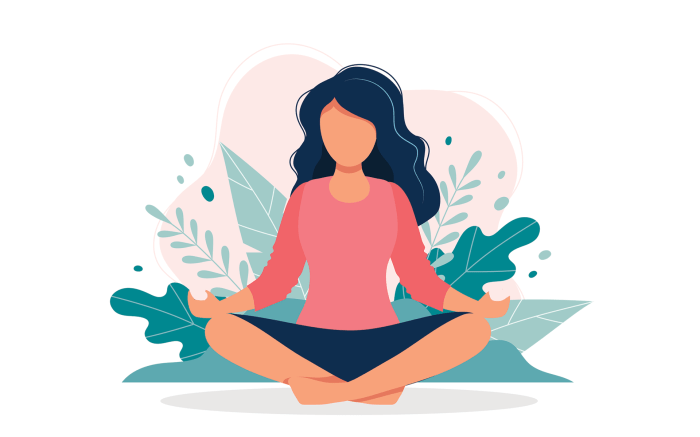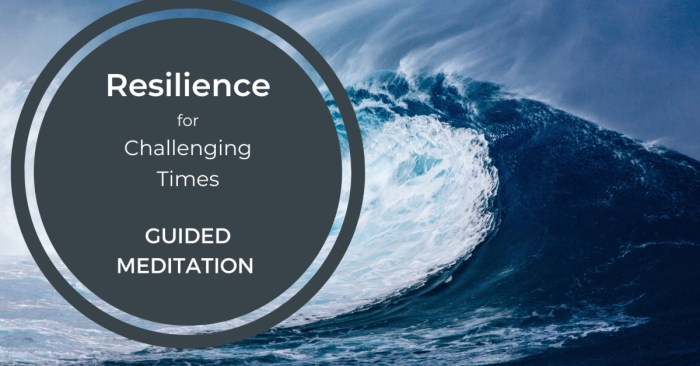How to Meditate for Developing Resilience and Emotional Balance sets the stage for a journey into the realms of mindfulness and mental well-being, offering valuable insights and practical tips for achieving emotional equilibrium.
Introduction to Meditation for Resilience and Emotional Balance: How To Meditate For Developing Resilience And Emotional Balance

Meditation is a powerful practice that can help individuals develop resilience and emotional balance in their lives. By incorporating meditation into a daily routine, individuals can cultivate a sense of inner strength and peace that allows them to navigate life’s challenges with greater ease.
Improving your mental clarity through meditation is essential for overall well-being. By following these 5 essential meditation tips, you can achieve a clearer mind and a more balanced life. Dive deeper into meditation practices with 5 Essential Meditation Tips for a Clearer Mind.
Benefits of Practicing Meditation for Mental Health
- Reduces stress and anxiety levels
- Improves focus and concentration
- Promotes emotional regulation
- Enhances self-awareness and mindfulness
How Meditation Helps in Managing Stress and Emotions, How to Meditate for Developing Resilience and Emotional Balance
- By calming the mind and body, meditation can lower cortisol levels and reduce the impact of stress on the body.
- Regular meditation practice can help individuals develop a greater sense of emotional awareness, allowing them to respond to challenging situations with more clarity and composure.
- Through mindfulness meditation, individuals can learn to observe their thoughts and emotions without judgment, leading to a more balanced and resilient mindset.
Types of Meditation Techniques

When it comes to developing resilience and emotional balance through meditation, there are various techniques that can be beneficial. Two popular methods include mindfulness meditation and loving-kindness meditation.
Learning how to meditate can be a powerful tool for emotional detox and healing. By practicing mindfulness and focusing on your breath, you can release negative energy and find inner peace. For more tips on how to meditate for emotional detox and healing, check out How to Meditate for Emotional Detox and Healing.
Mindfulness Meditation and Emotional Resilience
Mindfulness meditation involves focusing on the present moment without judgment. This practice can help individuals build emotional resilience by allowing them to observe and accept their emotions without becoming overwhelmed by them. By cultivating a non-reactive awareness of their thoughts and feelings, individuals can develop the ability to respond to challenging situations with calmness and clarity.
Loving-Kindness Meditation and Emotional Balance
Loving-kindness meditation, also known as metta meditation, involves directing feelings of love, compassion, and goodwill towards oneself and others. This practice can have a profound impact on emotional balance by fostering positive emotions and reducing negative ones. By cultivating feelings of kindness and compassion, individuals can enhance their overall emotional well-being and strengthen their relationships with others.
Unlocking your true mindfulness potential through meditation can lead to a deeper sense of self-awareness and clarity. By incorporating meditation into your daily routine, you can enhance your focus and reduce stress. Explore more on how to meditate for unlocking your true mindfulness potential at How to Meditate for Unlocking Your True Mindfulness Potential.
Steps to Meditate for Developing Resilience and Emotional Balance

Starting a meditation practice can be a transformative journey towards developing resilience and emotional balance. Here is a step-by-step guide to help you begin this practice and create a conducive environment for meditation.
Creating a Conducive Environment for Meditation
- Find a quiet and peaceful space where you can meditate without distractions.
- Set up a comfortable cushion or chair to sit on during your meditation practice.
- Dim the lights or light a candle to create a calming atmosphere.
- Consider using essential oils or incense to enhance relaxation during meditation.
Tips for Focusing on the Present Moment
- Start by taking a few deep breaths to center yourself and bring your focus to the present moment.
- Observe your thoughts without judgment and gently bring your attention back to your breath whenever your mind wanders.
- Focus on the sensations in your body, such as the rise and fall of your chest with each breath.
- Practice gratitude by reflecting on things you are thankful for during your meditation session.
Integrating Meditation into Daily Routine

Meditation is most effective when practiced consistently, as it allows individuals to build resilience and emotional balance over time. Integrating meditation into your daily routine is key to reaping the full benefits of this practice. Here are some ways to make meditation a regular part of your busy schedule:
Short Meditation Sessions
- Start with just a few minutes: Begin by incorporating short meditation sessions of 5-10 minutes into your daily routine. This can be done in the morning before starting your day or in the evening before bedtime.
- Utilize breaks: Take advantage of short breaks throughout the day to sneak in a quick meditation session. This can help reset your mind and improve focus for the rest of the day.
- Use meditation apps: There are various meditation apps available that offer guided meditation sessions of different lengths. Choose one that fits your schedule and preferences to make meditation more accessible.
Morning and Evening Routines
- Morning meditation: Start your day with a short meditation session to set a positive tone for the day ahead. This can help you approach challenges with a clear and focused mind.
- Evening wind-down: Incorporate meditation into your evening routine as a way to relax and unwind before bedtime. This can help reduce stress and improve sleep quality.
- Combine with other activities: Pair meditation with other daily habits, such as drinking your morning coffee or brushing your teeth before bed, to create a consistent routine that reinforces the practice.
Mindful Breathing and Body Scan Techniques

Practicing mindful breathing and body scan techniques are essential components of meditation for developing resilience and emotional balance. These techniques help in cultivating awareness, reducing stress, and promoting a sense of calmness and well-being.
Mindful Breathing for Emotional Balance
Mindful breathing exercises involve focusing on your breath and observing it without judgment. This practice helps in calming the mind, increasing self-awareness, and regulating emotions effectively. By paying attention to the breath, individuals can anchor themselves in the present moment and let go of worries or anxieties that may arise.
- Start by finding a quiet place to sit or lie down comfortably.
- Close your eyes and take a few deep breaths to center yourself.
- Focus on the sensation of your breath entering and leaving your body.
- Notice the rise and fall of your chest or the feeling of air passing through your nostrils.
- Whenever your mind wanders, gently bring your focus back to your breath without judgment.
Body Scan Meditation for Developing Resilience
Body scan meditation involves systematically focusing on different parts of the body, starting from the toes and moving up to the head. This practice helps in releasing tension, promoting relaxation, and developing a deeper connection between the mind and body.
- Lie down in a comfortable position and close your eyes.
- Begin by bringing your awareness to your toes, noticing any sensations or feelings present.
- Slowly move your attention up through each body part, releasing any tension or stress you may encounter.
- Allow yourself to fully experience the present moment without trying to change anything.
- Finish the body scan by focusing on your breath and feeling a sense of relaxation and calmness throughout your body.
Embark on your path to resilience and emotional balance with the transformative power of meditation, paving the way for a calmer mind and a more resilient spirit in the face of life’s challenges.